

Windows 2008 and the IsAlive Sanity Check - Brian Kern's Exchange Blog. Admins running Exchange Clusters are likely already familiar with volume mount points, but I'll provide a brief overview for those new to the topic: A mount point is a location on a disk that looks and acts like a folder (in a logical sense) but actually points to a physical disk logical unit number (in a physical sense).

Most cluster administrators use mount points to overcome limitations on the number of drive letters that can be assigned in a multi-node cluster. Some admins choose to use them just for convenience as it results in simplified paths to your databases and logs while still allowing you to divide the dbs and logs across many separate disk LUNs. (Our Exchange Team blog mentions mount points explicitly when discussing storage configurations - see Mount points are still around in Windows 2008, but if you're thinking of implementing them for Exchange, I recommend reading the following KB article first: Scenario We wound up killing store.exe with Task Manager.
Troubleshooting Cluster Logs 101 - Why did the resources failover to the other node? - Ask the Core Team. The most popular question everyone asks themselves before calling Microsoft Customer Service and Support (CSS) for assistance in determining a Root Cause Analysis be done.
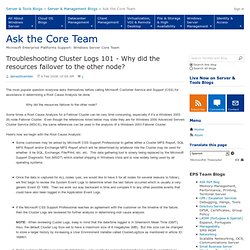
Why did the resources failover to the other node? Some times a Root Cause Analysis for a Failover Cluster can be very time consuming, especially if it's a Windows 2003 (8) node Failover Cluster. Even though the references listed below may state they are for Windows 2000 Advanced Servers Cluster Service (MSCS), the same references can be used in the analysis of a Windows 2003 Failover Cluster. Here's how we begin with the Root Cause Analysis: Some customers may be asked by Microsoft CSS Support Professional to gather either a Cluster MPS Report, SQL MPS Report and/or Exchange MPS Report which will be determined by whatever role the Cluster may be used for whether it be SQL, Exchange, File/Print, etc, etc. A physical disk resource may not come online on a cluster node. On a cluster node that is running Windows Server 2003, Windows Server 2008 or Windows Server 2008 R2, a physical disk resource may enter the Failed state when you try to move a group that contains the physical disk resource.

If you restart the cluster node that has the physical disk resource that did not come online, the problem is temporarily resolved. When this problem occurs, the following entries are logged in the Windows Server 2003 Cluster log for the physical disk resource that entered the failed state: 000020cc.000014d0::2010/01/23-19:40:39.929 ERR Physical Disk <Disk Q:>:DiskspCheckPath: GetFileAttrs(Q:) returned status of 87.000020cc.000014d0::2010/01/23-19:40:39.929 WARN Physical Disk <Disk Q:>:DiskspCheckDriveLetter: Checking drive name (Q:) returns 87. SQL Server 2008 installation fails if the Setup account does not have certain user rights. Consider the following scenario.
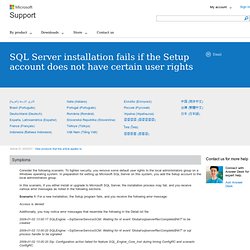
To tighten security, you remove some default user rights to the local administrators group on a Windows operating system. In preparation for setting up Microsoft SQL Server on this system, you add the Setup account to the local administrators group. In this scenario, if you either install or upgrade to Microsoft SQL Server, the installation process may fail, and you receive various error messages as noted in the following sections. SQL Server 2008 and R2 Cluster Best Practices - Pankaj Mittal [MSFT] Changing the SQL Port of a Clustered SQL Server 2008 in Win Server 2008R2. SQL Server clients may change protocols when the client computers try to connect to an instance of SQL Server.
Client computers that have Microsoft Data Access Components (MDAC) version 2.6, or later, can try multiple protocols or Interprocess Communication (IPC) mechanisms to establish connections to SQL Server.
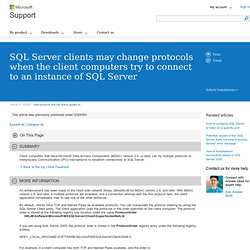
An enhancement has been made to the client side network library, Dbnetlib.dll for MDAC version 2.6, and later. With MDAC version 2.6, and later, if multiple protocols are available, and a connection attempt with the first protocol fails, the client application immediately tries to use one of the other protocols. By default, clients have TCP and Named Pipes as available protocols. How to configure SQL Server to listen on a specific port. This article describes static and dynamic port allocation in Microsoft SQL Server 2008, SQL Server 2005, or SQL Server 2000 .
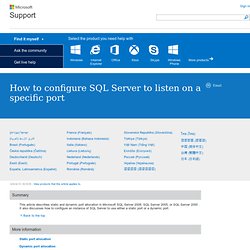
SQL 2008 R2 Named instance and static port. Hi Don, Please follow below steps to configure your named instance to listen on specific port For Standalone instance of the SQL server change the dynamic port of the named instance to the static port by using SQL server configuration manager in SQL 2005/2008.
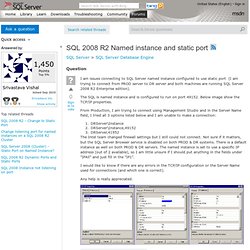
How to create the cluster.log in Windows Server 2008 Failover Clustering - Clustering and High-Availability. Windows Server Failover Clustering logs information about cluster activities including normal operations like updates between nodes as well as errors and warnings related to problems that occurred on the cluster in a text file called cluster.log.
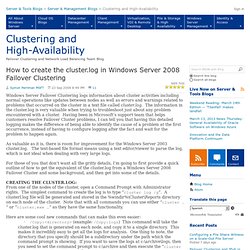
The information in the cluster.log is very valuable when trying to troubleshoot just about any problem encountered with a cluster. Having been in Microsoft’s support team that helps customers resolve Failover Cluster problems, I can tell you that having this detailed logging makes the difference of being able to identify the cause of a problem at the first occurrence, instead of having to configure logging after the fact and wait for the problem to happen again. As valuable as it is, there is room for improvement for the Windows Server 2003 cluster.log. The text-based file format means using a text editor/viewer to parse the log, which is not ideal when dealing with very large logs. Here are some cool new commands that can make this even easier: